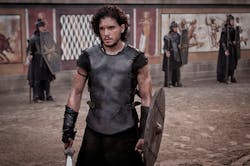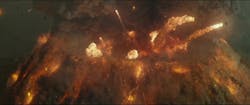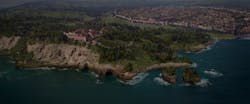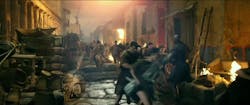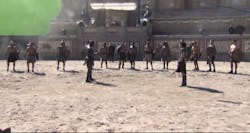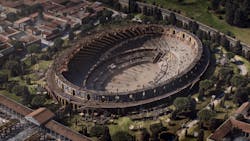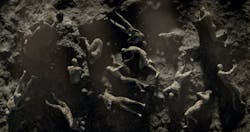Paul W.S. Anderson's movie, Pompeii, is epic in more ways than one. In many ways it mirrors another movie I am very fond of, Apollo 13. Apollo 13 was directed by Ron Howard. Ron went to great lengths to make sure that the movie and its setting were historically accurate. Paul also wanted to make a historically accurate film but the challenges were a bit different. Of course, the main story line and characters within the film are complete fiction whereas Apollo 13 followed real people. Likewise, many of those people were available for interviews while everyone died in Pompeii. Sorry for the spoiler but that is what happens when a volcano blows its top and buries the entire countryside in high temperature volcanic ash.
I was able to speak with Paul Anderson after I had seen the film in 3D and talked with the Visual Effects Supervisor, Dennis Berardi. Dennis started Mr. X, the group that handled the extremely impressive special effects for the film. I am not a film critic and will not be talking about that aspect of the film but I did enjoy the film and do recommend it to everyone.
Just in case you haven't heard about it, Pompeii is about a slave turned invincible gladiator named Milo (Fig. 1), played by Kit Harington, who falls in love with the beautiful Cassia (Emily Browning), the daughter of a wealthy merchant. Kiefer Sutherland plays the evil Roman Senator Corvis.
Related Articles
- Volcano Blows Its Top In Pompeii - Accurately
- RoboCop Returns With An Eye On Realism
- Spider-Man Swings Through A Virtual 3D World
- Technologies Combine For Low-Cost Motion Capture VFX
- Prometheus Takes Flight With Cutting-Edge VFX Technology
The fictional part of the story is compelling and what most moviegoers will talk about with the volcano and city more as a backdrop. I found the film even more fascinating because I had an eye out for those background details.
I was going to start out talking about Paul's interest in Pompeii that started in grade school. One of the things that grabbed him was the plaster casts that were made by archaeologists that found the hundreds of hollow areas. These turned out to be where people and animals were as they were covered by volcanic ash when Mount Vesuvius erupted (Fig. 2). Even loaves of bread were preserved, or at least their shape. They were almost instantly vaporized and the ash cooled leaving the hollow areas in their place. These are seen in the movie at the start and end but no comments are made about them so a viewer may not know what they really are unless they researched the event or read this article (or one of the thousands of others like this on the web).
What Paul wanted to do was not just tell part of the story but as much as possible including the fact that Pompeii was hit not just by an exploding volcano, which is bad enough, but also a major earthquake and resulting tidal wave. Pliny the Younger wrote about how the Bay of Naples emptied itself, and, of course, refilled rather quickly by the devastating wave that destroyed most ships in the area as well.
To do this they recreated the entire area, digitally, in great detail (Fig. 3). Paul and his executive crew mapped out the entire area including the details of the city starting with helicopter views done before filming of the movie even started. Many of the shots of Mount Vesuvius, when it was not erupting, are from the current day.
The archaeological digs had already provided a great bit of detail about the layout of the city and the entire thing was recreated digitally by Mr. X. They also added virtual people seen moving about (Fig. 4). The size and location of not just major items like the forum or temples is accurate but all of the city was recreated digitally.
Even the volcano, earthquake and tidal wave effects were done in great detail using simulation software developed by Mr. X to handle things like the pyroclastic flow of material from Mount Vesuvius (see Volcano Blows Its Top In Pompeii - Accurately). The eruption in the movie was based partly details from Mount St. Helen and the 2010 eruption of Eyjafjallajökull in Iceland.
For a movie, the art and costume designers often create their own rendition and their studio often has they drawings displayed. In this case, they had pictures of frescoes and other artwork from Pompeii.
Anderson had an eye out for all the details (Fig. 5) from the architecture of the buildings to the contents of the shops and vendors. This was all preserved by the eruption because it happened so quickly.
Details like the height of sidewalks were replicated in the film. I especially like the stepping stones across the streets. These were common in Roman cities because the width of the wheels for carts and chariots were standardized (see Technologies Combine For Low-Cost Motion Capture VFX). Horses and vehicles could easily navigate the streets while allowing pedestrians to cross sometimes rather muddy streets. This standard indirectly affected the design of the Space Shuttle's booster rockets but that is another story.
Building everything to scale can have its disadvantages as Kirk Douglas discovered when he produced and starred in The Viking (1958). They built the ships to scale but people were a little smaller. It made for tough rowing. Luckily it was less of an issue for the actors on Pompeii.
The story behind the movie Pompeii is not just about historical accuracy but also streamlined production. It was an independent film so the budget was limited and the director and producers needed to make a dollar work like two or three on a conventional picture. One of the ways to do this was to optimize the special effects and this required planning and scheduling.
Paul Anderson worked with Production Designer Paul Austerberry and Visual Effects Supervisor Dennis Berardi to determine the optimum shooting angle for major scenes like those in the arena. This allowed them to construct only 30% and use green screen digital effects when wider shots were required (Fig. 6).
This approach had the affect of limiting the amount of change the director could make during shooting but it allowed unlimited shooting within the confines without affecting special effects integration late in the development of the movie. This can be very costly and it can push out the delivery of the film because even computers can only work so fast. Hi def digital rendering can take days for a frame where very complex simulation is involved and even hours for simpler ones. Keep in mind the resolution and the 3D requirements that directors and producers now need to deal with.
Of course, there are physical tricks to play as well. Reusing a set for another view (Fig. 7) is par for the course.
Simulation was used before shooting for the picture actually started. Berardi was able to generate virtual views and Paul Anderson was able “lens it” to take a virtual look. He then indicated what areas would have to be shot so production designer Paul Austerberry only needed to be a small fraction of the environment what would be needed for the film.
Anderson actually signed off on over 150 visual effects before filming even started. These included the eruption and chariot chase that starts in the arena (Fig. 8) that appear at the end of the film. Sign off for special effects during filming was very quick, usually a week with final sign off in under two weeks.
When asked about what changes he has seen over the years in film making Paul noted that the relationships between the director, production designer and visual effects has become more important. Dennis Berardi actually had an office down the hall from Paul.
I asked Paul about which part of the film he was most proud of. It was the last five minutes where everything comes together. It shows the eruption, earthquake and the tidal wave.
So I will end with the beginning (Fig. 9).
I suspect that the comments about Pompeii will be similar to one I heard third hand about Apollo 13 where some one said, “That could never happen. They just made it up.” In this case they did make up the main story but the event and the environment were very real. My thanks to Paul and his entire crew for giving us this historical treat.
About the Author
William Wong Blog
Senior Content Director
Bill's latest articles are listed on this author page, William G. Wong.
Bill Wong covers Digital, Embedded, Systems and Software topics at Electronic Design. He writes a number of columns, including Lab Bench and alt.embedded, plus Bill's Workbench hands-on column. Bill is a Georgia Tech alumni with a B.S in Electrical Engineering and a master's degree in computer science for Rutgers, The State University of New Jersey.
He has written a dozen books and was the first Director of PC Labs at PC Magazine. He has worked in the computer and publication industry for almost 40 years and has been with Electronic Design since 2000. He helps run the Mercer Science and Engineering Fair in Mercer County, NJ.
- Check out more articles by Bill Wong on Electronic Design
- Bill Wong on Facebook
- @AltEmbedded on Twitter

